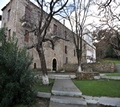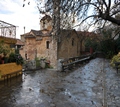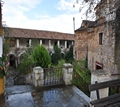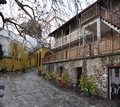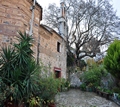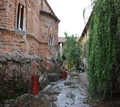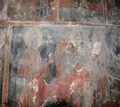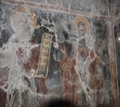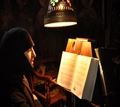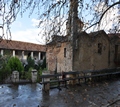
It is located on Mount Taygetos, on its eastern side, at an altitude of 500 meters, in a green landscape and is 19 km from Sparta. According to an inscription, the I.M. was built in 1639 on the ruins of an older Christian church. The name "Zerbitsa" is probably a Slavic toponym and is interpreted as "Metohion".
The catholicon of the I. Monastery is a cruciform inscribed tetragonal church with a dome and is divided into three parts: the apse, the main church and the three-niche Holy Vima. Many holy relics are kept in the monastery, while in the year 1968 the Museum of the monastery was founded with a number of sacred relics.
According to the inscription, which is located on the lintel of the Royal Gate of the interior of the Holy Catholic Church, the Holy Cross Monastery was built in 1639 and painted in 1669. The frescoes are of a post-Byzantine style.
The establishment of the Monastery is connected with the miracle of finding an icon of Panagia Brefokratoussa that came from a monastery that existed before in the 12th century, with the title of Kyra Panagia.
The miraculous icon of the Most Holy Theotokos, Lady Zerbitsis, is enthroned in the left shrine of the main Church and is inside a wooden box, framed by silver lining.
In the same place where the monastery is built today, there was a temple of the 3rd BC in ancient times. century. In fact, finds from this era are kept in the Museum of the Holy Monastery.
The Katholiko is a spacious building, a complex tetrakion cruciform inscribed rhythm with a simple and two choirs, Athonic type.
Above the narthex on the second floor, with an entrance from the outside to the west, three chapels have been formed: of the Holy Trinity, of the Holy Forerunner and of Agios Nektarios.
The paved courtyard, due to the slope of the ground, consists of two stepped levels. In the lower courtyard are the cells, the old and the newest, the Bank, the workshops, the hagiography, the synod, the Abbot, the arches around the beautiful Church, the garden and several flowers. In the upper courtyard are the guesthouses, Archontariki and Despotiko, with the century-old huge plane tree in the middle and the large impressive hydrangeas around.
By ministerial decision, the Holy Monastery has been classified as a historic preserved monument. During the period of the German occupation, in 1941, it suffered a terrible bombardment.
In the year 1968, the Museum of the Holy Monastery was founded with relics, including the gold-embroidered Epitaph of the year 1538 and the gold-embroidered Image - Banner of the Dormition of the Virgin Mary of the year 1707.
The monastery complex is quite large and has a number of chapels (fourteen in total). as well as spaces that serve monastic life and the reception of visitors who come to worship.
The monastery is female and active.
In the Holy Monastery, every Sunday and major holiday, the Divine Liturgy is celebrated
Editor: Fotini Anastasopoulou










